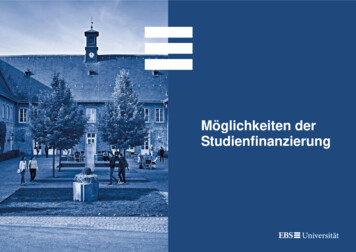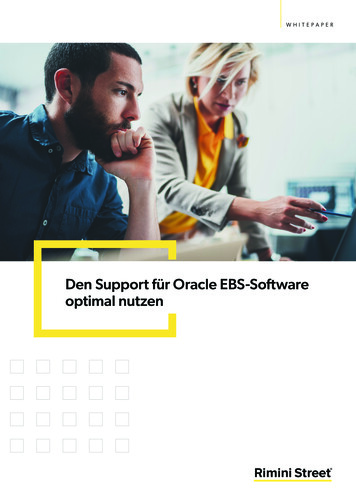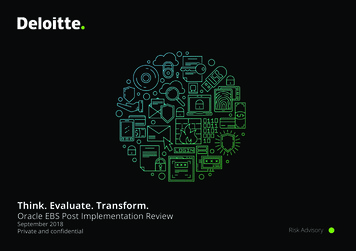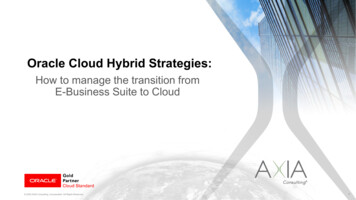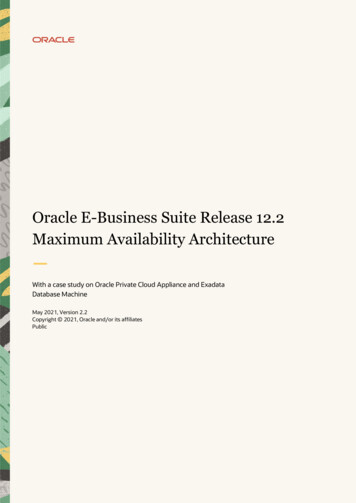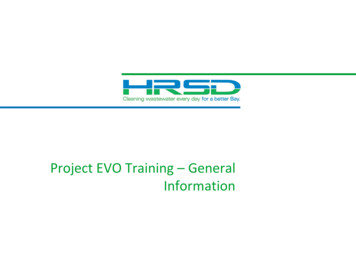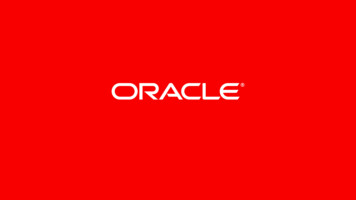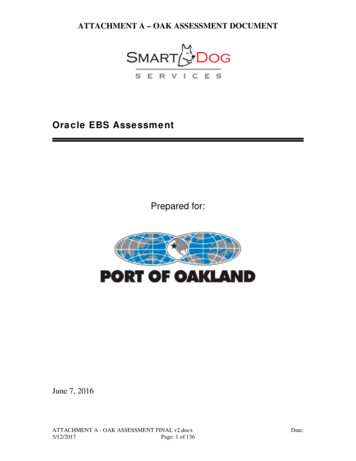
Transcription
ATTACHMENT A – OAK ASSESSMENT DOCUMENTOracle EBS AssessmentPrepared for:June 7, 2016ATTACHMENT A - OAK ASSESSMENT FINAL v2.docx5/12/2017Page: 1 of 136Date:
ATTACHMENT A – OAK ASSESSMENT DOCUMENTThis page intentionally left blankATTACHMENT A - OAK ASSESSMENT FINAL v2.docx5/12/2017Page: 2 of 136Date:
ATTACHMENT A – OAK ASSESSMENT DOCUMENTTable of ContentsTable of Contents . 31. Executive Summary . 52. General Recommendations . 92.1.2.2.2.3.3.Upgrade Oracle EBS to Version 12.2.5 . 9Reporting. 13Training and Documentation . 16Oracle Enterprise Asset Management (eAM) Assessment & Recommendations . 193.1.3.2.3.3.3.4.4.Executive Summary – Oracle eAM . 19Current Baseline . 20eAM Customizations . 20Recommendations in the eAM Area . 20Projects and Grants Assessment & Recommendations . 294.1.4.2.4.3.4.4.5.Executive Summary – Projects and Grants. 29Current Baseline . 29Projects and Grants Customizations. 31Recommendations in the Projects and Grants Area . 31Property Manager Assessment & Recommendations . 375.1.5.2.5.3.5.4.6.Executive Summary – Property Manager . 37Current Baseline . 37Property Manager Customizations . 37Recommendations for Property Manager . 37Oracle Time and Labor & Payroll Assessment & Recommendations . 436.1.6.2.6.3.6.4.7.Executive Summary – Payroll and OTL . 43Current Baseline . 43Customizations . 45Recommendations for Payroll and OTL . 45Human Resources Assessment & Recommendations. 557.1.7.2.7.3.7.4.8.Executive Summary – Human Resources . 55Current Baseline . 55Customizations . 55Recommendations for Benefits, Self-Service HR and Human Resources . 56General Ledger Cost Allocations Assessment & Recommendations . 698.1.8.2.8.3.8.4.9.Executive Summary – GL Cost Allocations . 69Current Baseline . 69GL Cost Allocations Customizations . 69Recommendations for GL Cost Allocations . 69Accounts Payable Approvals & Accruals Assessment & Recommendations . 719.1.9.2.9.3.9.4.10.10.1.Executive Summary – AP Approvals & Accruals . 71Current Baseline . 71AP Accrual & Approval Customizations. 72Recommendations for AP Accruals & Approvals . 72Purchasing . 75Executive Summary – Purchasing. 75ATTACHMENT A - OAK ASSESSMENT FINAL v2.docx5/12/2017Page: 3 of 136Date:
ATTACHMENT A – OAK ASSESSMENT DOCUMENT10.2.10.3.10.4.11.Current Baseline . 75Purchasing Customizations. 76Recommendations for Purchasing . 76Technical Architecture . 8111.1.11.2.11.3.12.Introduction. 81Current Baseline . 81Recommendations . 83Applications Technical . 4.13.5.13.6.Executive Summary . 85Background . 86Technical Overview. 86Interfaces . 89Recommendations . 93Implementation Roadmap . 97Implementing the Assessment Recommendations –Phasing . 97Training. 106Timeline for Design and Execution Plan . 107Implementing the Assessment Recommendations –Project Approach . 114Critical Success Factors . 116Upgrade Timeline . 117Appendix A: Oracle Application Express (APEX) . 118Appendix B: Payroll and OTL Customizations. 120Appendix C: Human Resources Customizations. 127Appendix D: Oracle User Productivity Kit (UPK) . 130Appendix E: Workshop Schedule and Participants . 131Glossary of Acronyms: . 136ATTACHMENT A - OAK ASSESSMENT FINAL v2.docx5/12/2017Page: 4 of 136Date:
ATTACHMENT A – OAK ASSESSMENT DOCUMENT1. Executive SummaryScope of This AssessmentThe charter of this Assessment is to: Evaluate how the Oracle E-Business Suite (EBS) applications are supportingthe Port of Oakland’s business requirements and how the Port is currentlyusing them Create recommendations on how the system can be improved to meet currentbusiness needs, reduce inefficiencies and decrease the amount of manualeffort involved in core business processes – all within the context of a plannedEBS upgrade. Create recommendations on how the system can better support changingbusiness requirements as the Port’s business evolves Establish a roadmap to enable the Port to use EBS to better support thebusiness now and moving forward Evaluate the current EBS version and technical architecture to determine howto bring them current and reduce business risk.System FoundationThe foundations for the current systems need to be updated. The Port’s currentversion of the Oracle EBS applications will be moved to Oracles’ Extended Supportat the end of 2016 and to Sustaining Support at the end of 2019. While ExtendedSupport will likely not greatly increase the Port’s risk, the potential move tosustaining support would increase risk considerably and will need to be avoided.The necessary foundation should include an upgrade to the most current supportedversion of EBS – 12.2.5 – and an update of the technology infrastructure. Oracleprovides an upgrade path from the current version, 12.1.1 to 12.2.5.The EBS upgrade recommendation to upgrade to version 12.2.5 is discussed in detailin Section 2.1 Upgrade Oracle EBS to Version 12.2.5.Current EnvironmentIn most areas, the current EBS setup is adequately supporting business processesefficiently. However, in some areas, the system is simply not sufficiently supportingkey business requirements. People are doing what they can to run the business andmake-do, but they’re not getting much help from the current systems environment. Inthese areas, this is a broken ERP system that is not supporting the business properly,and the business users are generally frustrated and unhappy with it.Lease Management, which is supported by the Property Manager application, isexperiencing significant issues. These are a result of an inadequate and basicimplementation of the module from the beginning, and also from a significant numberof unresolved system bugs. Subsequent versions of the Property Manager applicationsignificantly improve system functionality and resolve system bug issues. As a result,and upgrade of EBS will considerably benefit the Lease Management business areawith better support of business processes and fewer system issues. This area isdiscussed in detail in Section 5 Property Manager Assessment & Recommendations.ATTACHMENT A - OAK ASSESSMENT FINAL v2.docx5/12/2017Page: 5 of 136Date:
ATTACHMENT A – OAK ASSESSMENT DOCUMENTConversely, in the Maintenance Area, the current version of the Enterprise AssetManagement application is richly functional, but is not being used to the extent that itshould. Based on the requirements of the business, Oracle EBS is a good fit, howevercritical system capabilities are not being used and have even been worked-around.Only the most basic business processes were originally implemented and are beingsupported on the system and many others are being administered manually with thehelp of outside tools like spreadsheets and databases. Not only does this result in a“reactive” maintenance environment, but it also causes issues downstream forPurchasing, Accounts Payable, Accounting, and “Customers” – groups that utilizemaintenance services.Better unitizing the system can provide significant opportunity for improving the useand value of Oracle eAM at Port of Oakland to move more toward a ‘proactive”maintenance model. We have recommended a holistic approach that addresses bothbusiness process improvements as well as improvements in the setup, dataconfiguration and use of Oracle eAM. The EBS upgrade and additional eAMfunctionality will make the system more user-friendly to use, but upgrading thesystem would not be required for implementing most of the recommendations in thisarea.This area is discussed in detail in Section 3 Oracle Enterprise Asset Management(eAM) Assessment & Recommendations.Using EBS Projects and Grants causes a unique situation for the Port. A significantlimitation caused by Grants inhibits the seeded integration between EBS Projects andProject Management. Unfortunately, the upgraded system 12.2.5 will not helpresolve the issue. This results in the Port’s inability to utilize seeded ProjectManagement functionality to address considerable pain points in the areas offorecasting, budgeting and scheduling.It is likely that Project Management functionality would greatly improve the Port’sability to manage projects, but the link between Projects and Project Managementwithin the context of Grants will need to be addressed – either by extensions thatbuild a “bridge” between the two, or the removal of Grants with an accompanyingmove of Grants-supported activities to within Projects.This area is discussed in detail in Section 4 Projects and Grants Assessment &RecommendationsIn other areas like Human Resources, Payroll and Accounting, where the system issupporting the business well, there are some opportunities to utilize additional currentfeatures to improve use of the system. Similarly, there are improvements in theupgraded system that will be useful moving forward. Likewise, there are a fewopportunities for training on system features that will also provide benefit by helpingATTACHMENT A - OAK ASSESSMENT FINAL v2.docx5/12/2017Page: 6 of 136Date:
ATTACHMENT A – OAK ASSESSMENT DOCUMENTthe system users to take advantage of features that they are not currently trained touse.There is no system documentation and there are no user procedures on how to use thesystem. No formal training has been provided to any of the current business users.Consequently, system knowledge has been handed down informally acrossgenerations of users in a kind of “whisper chain”. As a result, system automation isnot being used in key areas, bad practices are common, and users are unaware of whythey do what they do in the system. Further, key business users do not know thecapabilities of the system and how to use it properly to streamline their work effort.More detail on this is in Section 2.3 Training and Documentation.Roadmap: The Go-Forward PlanThis assessment provides an understanding of what the system can do for the Port adprovides specific recommendations on what to do. The next significant steps in theprocess should be how to get there. As discussed in Section 13 ImplementationRoadmap we anticipate that the next step will be a formal planning effort of theupgrade project, to most likely include RFP processes. The reality is that thisplanning process will take some time, and as a result, there will likely be time toimplement at least some (if not most) of the recommendations that provide goodbusiness value yet are not complex to implement and don’t require functionality formthe upgrade.As a result, we recommend an effort to determine which recommendations can beimplemented before the upgrade within the time period created by the upgradeplanning and RFP effort. Those recommendations that we are unable to address priorto the upgrade should then be included in the upgrade scope along with therecommendations that necessarily have to be part of the upgrade because of theircomplexity or because they require functionality from the upgraded EBS release.Oracle EBS standard functionality is generally a good fit for the Port of Oakland’sbusiness requirements. The future success of the system will depend upon our abilityto use the system upgrade as an opportunity to fix broken processes whether they arethe result of inherent system issues, lack of training, or oversights during the originalimplementation that resulted in the inability to fully use the system’s built-infunctionality. There are opportunities to realize quick wins by addressing some of themore basic, less complex and more valuable opportunities prior to the upgrade.ATTACHMENT A - OAK ASSESSMENT FINAL v2.docx5/12/2017Page: 7 of 136Date:
ATTACHMENT A – OAK ASSESSMENT DOCUMENTThis page intentionally left blankATTACHMENT A - OAK ASSESSMENT FINAL v2.docx5/12/2017Page: 8 of 136Date:
ATTACHMENT A – OAK ASSESSMENT DOCUMENT2. General Recommendations2.1. Upgrade Oracle EBS to Version 12.2.5An upgraded EBS foundation will allow the organization to not only reducebusiness risk and decrease support costs, but also to: Mitigate current business issues Re-design key business processes to be more efficient Leverage the new capabilities of the latest version of the softwarewhere it makes sense Provide a foundation to implement additional EBS functionalitythat may provide additional business value in the future Avoid lapsing into an essentially unsupported version in the futureBusiness Functions ImplicationsPort of Oakland is currently running version 12.1.1 of the Oracle EBSapplications, which is stable but not adequate for meeting basic business needsin certain business areas like Property Management and, to a lesser extent,Enterprise Asset Management, Projects and Grants.Upgrading to the latest version of EBS, currently 12.2.5, would enable thePort to improve the basic functionality in Property Manager and enable theteam supporting leases to operate in a fundamentally more efficient manner.Moreover, new functionality has been added to the Projects, Grants, Payroll,and Enterprise Asset Management functions that would allow the teamssupporting those business areas to use the system to operate in anincrementally more efficient manner.These opportunities are discussed in more detail by functional area later in thisdocument.Oracle Support Implications12.1.1 poses potential risks inherent in sticking with a version that is nowscheduled to move to Oracle’s Sustaining Support model at the end of 2016and to Extended Support at the end of 2019.Below is Oracle’s support policy timeline for the Port’s current release, aswell as for 12.2, which is Oracle’s most recent release. Oracle’s supportlifecycle is defined by versions of the EBS applications moving to differentphases of support as they age. The three phases of support are Premier,Extended and Sustaining. The characteristics of the three phases are alsodiscussed below.ATTACHMENT A - OAK ASSESSMENT FINAL v2.docx5/12/2017Page: 9 of 136Date:
ATTACHMENT A – OAK ASSESSMENT DOCUMENTRelGeneraleaseAvailability12.1 May 200912.2 September 2013PremierSupport EndsDecember 2016September 2018Extended SupportEndsDecember 2019September 2021SustainingSupport EndsIndefiniteIndefinitePremier Support: Major product and technology releases Technical support Access to My Oracle Support Updates, fixes, security alerts, data fixes, and critical patch updates Tax, legal, and regulatory updates Upgrade scripts Certification with most new third-party products/versions Certification with most new Oracle productsExtended Support: Major product and technology releases Technical support Access to My Oracle Support Updates, fixes, security alerts, data fixes, and critical patch updates Tax, legal, and regulatory updates Upgrade scripts Certification with most existing third-party products/versions Certification with most existing Oracle products Extended Support may not include certification with some newthird-party products/versions.Sustaining Support: Major product and technology releases Technical support Access to My Oracle Support Fixes, updates, and critical patch updates created during thePremier Support stageATTACHMENT A - OAK ASSESSMENT FINAL v2.docx5/12/2017Page: 10 of 136Date:
ATTACHMENT A – OAK ASSESSMENT DOCUMENT Upgrade scripts created during the Premier Support stageSustaining Support does not include New updates, fixes, security alerts, data fixes, and criticalpatch updates New tax, legal, and regulatory updates New upgrade scripts Certification with new third-party products/versions Certification with new Oracle productsThe main difference between Premier and Extended support is that Oracle willnot support certification with some new Oracle or third-party products/versions when a customer is on a version that falls to Extended Support.Clients normally do not have significant issues with this restriction unless theyare actively adding to their systems footprint with new applications. Release12.1.1 is currently scheduled to move to Extended support at the end of 2016.Conversely, the move to Sustaining Support introduces significantly morerisk. Clients on EBS versions that are in Sustaining Support no longer receivenew updates, fixes, data fixes, patch updates, or new tax or regulatory updates.This means that Oracle no longer proactively provides support for theseclients.For example, for actively supported versions, Oracle periodically releasespatch-sets that are highly recommended and/or required to be applied to theEBS applications to ensure lower risk to ongoing business activities. Theseperiodic patch-sets are no longer provided with Sustaining Support, but arevital in that they: Provide the most stable platform by fixing known software issues Keep the software legislatively updated with regulatoryrequirements Fix known issues and bugs Provide a baseline from which to effectively work with OracleSupport on Service Requests, including production down issues.The latter of these is especially significant in that it puts the organization atconsiderable risk if there is a major issue that results in a production downstate, or one that causes a major disruption to normal business activities.Instead of being proactively managed by Oracle, issues will be reactivelymanaged, which could result in greater down-time while critical issues arebeing resolved.The Port has a good amount of time to upgrade EBS before the current 12.1.1version falls into Sustaining Support at the end of 2019.ATTACHMENT A - OAK ASSESSMENT FINAL v2.docx5/12/2017Page: 11 of 136Date:
ATTACHMENT A – OAK ASSESSMENT DOCUMENT2.1.1. Upgrade versus Re-ImplementThe recommendation includes an Upgrade of the EBS applications(versus a re-implementation). Unlike a re-implementation, an upgradeprovides a technical path, supported by Oracle, which moves theapplications from 12.1.1 to R12.2.5 without the need to re-configure theapplication setups or convert data from one system to the other.Fortunately, the Port’s specific circumstances retain the possibility ofleveraging the upgrade path. These requirements include the ability tokeep the Chart of Accounts structure, the ability to retain the currentAccounting Calendar, and the desire to keep core application data.Without significant need for data cleanup.2.1.2. Upgrade Can Occur When OptimalThe upgrade can be the first primary step or phase, however, there are asignificant number of improvements that can take place before, during orafter the upgrade. As discussed in Section13 Implementation Roadmap,it may make sense to address some of the higher-value, lowercomplexity recommendations/opportunities while the planning andevaluation for the upgrade are being completed2.1.3. Architecture Implications of 12.2As discussed in Section 11 Technical Architecture, R12.2 is built onOracle WebLogic Server, which is Oracle’s Strategic ApplicationsServer. It is designed to provide a standards-based, mission critical andsecure platform for organizations developing and deploying large-scale,distributed middleware environments. As the strategic applicationserver, the upper-level Fusion Middleware products and OracleApplications portfolio have adopted it as the foundation of theirdeployment and integration infrastructure. The bottom line is that thetechnical and server resource requirements are quite different from12.1.1.As a result, the additional infrastructure required to support thearchitecture could add additional cost to the Port’s hardware hostingcosts. The amount of additional cost is currently unknown, but ananalysis with the hosting provider should be conducted to determinethese additional costs.2.1.4. Business Benefits Lowers business risk of eventually sliding into SustainingSupport where support would be limited for production-downissues or other significant issues that could cause majordisruptions to businessATTACHMENT A - OAK ASSESSMENT FINAL v2.docx5/12/2017Page: 12 of 136Date:
ATTACHMENT A – OAK ASSESSMENT DOCUMENT Provides the foundation to address key pain points in thebusiness; leverage new functionality; mitigate manualprocesses; re-design old processes2.1.5. Estimated Complexity and Business BenefitEstimated Change Complexity: 5Estimated Business Benefit: 52.2. Reporting2.2.1. Implement a Transaction Reporting and Drill-downSolutionAcross all areas, system users expressed frustration with the perceivedabsence of self-service transaction reporting from EBS. OracleDiscoverer is the current self-service reporting tool, but the smallnumber of users with access to Discoverer and those that find it usefulare minimal, which essentially renders it ineffective.For the most part, business users have to go through IT to get newreports developed and existing reports changed or fixed regardless of thecomplexity of the information being sought. This results in frustration innot being able to access business-critical information in a timely manner,if at all.The Port should consider a scalable, self-service and user-friendlyreporting solution to replace Discoverer and eliminate the existingvolume of custom transaction analysis reports. This is especiallyrelevant as decisions are made on which reports need to be retrofittedduring the upgrade. If a number of custom reports can be replaced byproviding a self-service tool for the business users to create themselves,the complexity, timeline and cost of the upgrade will be reduced.According to Oracle Business Intelligence Discoverer Statement ofDirection published in March 2014, the Premium Support for OracleDiscoverer has ended back in June 2014, and the Extended Support willend in January 2017.Oracle’s recommended replacement for Discoverer is the OracleBusiness Intelligence Foundation Suite (OBIFS), formally known asOracle Business Intelligence Enterprise Edition (OBIEE). OBIFS is anenterprise business intelligence tool that has a lot of additional featuresand functionalities in comparison to Discoverer. It is understood thatPort of Oakland already has a license to use this software.ATTACHMENT A - OAK ASSESSMENT FINAL v2.docx5/12/2017Page: 13 of 136Date:
ATTACHMENT A – OAK ASSESSMENT DOCUMENTAn alternative or supplemental approach to OBIFS would be toimplement Oracle Application Express (APEX), which is a web-basedapplication development tool that is embedded into the Oracle database.APEX can be used as a platform to provide ad-hoc, self-service access tothe business users for EBS information. APEX is already owned by thePort since it is licensed with the Oracle EBS applications.Once a report template is created, a business user can easily modify it tomeet their needs, within controlled boundaries, as well as export thereport from the browser to file types such as PDF, CSV or Word. Itprovides a robust toolset for self-service, drillable reporting. APEX isdiscussed in more detail in Appendix A: Oracle Application Express(APEX).Some of that key features of APEX are that it: Integrates seamlessly with Oracle E-Business Suite:o It accesses the same real time transactional data as EBSo It utilizes the same login credentials.o It is available from the standard Oracle EBS Navigatormenus without requiring a second login. Requires no additional licensing as it is embedded into theOracle database. Simple to learn and use; a developer with SQL and PL/SQLskills will find APEX development easy to pick up. Can be used to quickly deploy data entry forms with a modernweb-based look-and-feel. Can be used to deploy REST-based web services for externalapplications to interact with Oracle Applications. Can be used to build interactive reporting pages that allow a userto group, drill and summarize data to their own individualrequirements. Data can then be exported to Excel, HTML or to aPDF.2.2.1.1. Business Benefits Reduces the workload on IT to provide reporting Enables faster access to transaction information to the businessusers Facilitates an enterprise-wide reporting strategy and standards Provides business users with real-time visibility to data that canbe acted upon.2.2.1.2. Special Considerations Third-party ad-hoc reporting tools are available, but wouldrequire additional licensing costs.ATTACHMENT A - OAK ASSESSMENT FINAL v2.docx5/12/2017Page: 14 of 136Date:
ATTACHMENT A – OAK ASSESSMENT DOCUMENT A self-service reporting solution can be slowly introduced intothe business with an initial limited footprint, then grown as thebusiness gains experience using it and can better determinewhere/how to use it better moving forward.User training is necessary for this tool to be effectivelyleveraged by the business teamSmartDog has delivered an initial product demonstration ofAPEX to the Port’s IT Team.2.2.1.3. Estimated Complexity and Business BenefitEstimated Change Comple
Purchasing, Accounts Payable, Accounting, and "Customers" - groups that utilize maintenance services. Better unitizing the system can provide significant opportunity for improving the use and value of Oracle eAM at Port of Oakland to move more toward a 'proactive" maintenance model.
